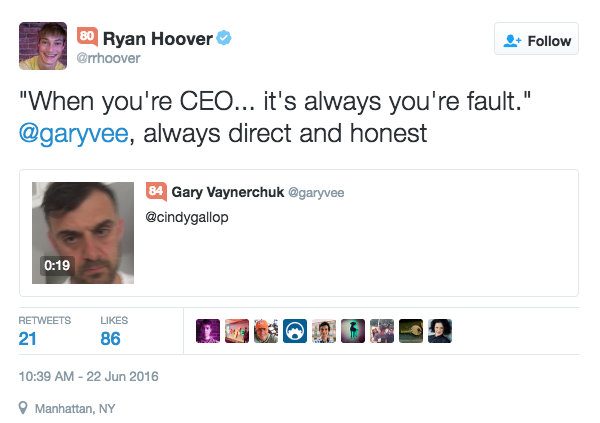Gary Vaynerchuk is one of the biggest names you see right now in the new technology and social media sphere. His presence on and offline is pretty impressive. He is always on and really has established his brand to be one that is unique, memorable, and engaged.
Personally, I am amazed at the amount of work he does each and every day. I follow him on all of the social media platforms (Snapchat is definitely my favorite along with his videos). I have all of his books, and had the chance to review his latest #AskGaryVee book just a few months ago. It was a great book to read and share with my students in my social media class.
Another area I also work in (and teach) is in crisis communications, and there was a particular situation that occurred this week for Gary while in Cannes. It was reported by several outlets (including Fortune and Adweek) about an email that went out asking for “attractive females and models only” to come to a party VaynerMedia and Thrillist were throwing in Cannes.
While most of the articles you have seen this case, I feel I am coming from a different perspective on this. I am coming to this perspective as a professor who teaches, researches, and consults in crisis communication.
I do find it interesting to see how the responses have shaped the narrative for this situation for Gary. Here are some of my takeaways.
Welcome to the era of the online microscope for everyone. We talk about the era of paparazzi when it comes to celebrities and how if they make one move that is not consistent with their brand, it’s all over the news. This appears to be happening now to influencers and social media prominent professionals as well.
This is one of the things we have to acknowledge and address when we enter any type of space – we have to have a balanced perspective of what happens in any given channel, community, and situation. This is one thing I stress to my students about when it comes to social media. So many times, we only focus on the wonderful things it brings to us (and I fully agree with this – it’s been a true game changer for me and my work). However, there is a dark side to social media and we have to look at – what could go wrong? What could happen to spark a crisis or even a negative situation for us?
We all aim to be influential as well – we are seeing the trend of how influencers (now micro-influencers) are becoming more prominent each and every day for brands, businesses, and within society. This was actually the subject of my very first published research article a few years ago. But, the question is, at what cost? Are those who are in this position prepared for this? I think this is definitely a discussion we all need to have for sure in our communities.
Research can explain the rise of outrage related to this issue. We talk about the differences in crisis communication research related to hazard and outrage (see Lachlan and Spence’s work) and how people attribute each of these differently and what they are expecting in terms of responses and message strategies. I have tried to approach this into my own research and work looking at the situational q-sort as well, and how it is different (and similar sometimes) depending on the communication channel being utilized depending on the situation. This case is a clear example where there was a lot of outrage about this, and this sparked a viral trend online, which then translated into the traditional media covering this.
This case is a clear example where there was a lot of outrage about this, and this sparked a viral trend online, which then translated into the traditional media covering this. I share this video a lot in my classes from Tim Coombs and how he discusses this via social media and crises.
Crisis communication theory can also help explain this. I have to be honest, I am more of an applied researcher myself, but I do think in this case, we can look at the research to help understand the reaction and responses (as well as framing narratives) in this case. There is a systematic approach in crisis communication research that allows people (and brands) to test these ideas in crisis communications while integrating theory and research into evidence-based ideas rather than speculation.
Tim Coombs (now at Texas A&M) has developed the Situational Crisis Communication Theory (otherwise known as SCCT) to address this. Tim is one of the best researchers (and colleagues) I know in the area and his work has contributed significantly to the research field as well as practice. Tim has a lot of great videos online on the SCCT, but this one (even though it is a few years old) gives a concise overview of what the SCCT is.
Gary addressed the message head on. What I felt Gary did that worked for him was not only message strategy he used in handling this situation but the timing aspect and channel(s) he approached in addressing his audience.
Gary has built a community and brand for himself when it comes to how transparent he has become online. He went directly to the source and channel in which the conversation was happening on. This is a key point to take on, but what I felt really added to the human element (in an age where technology is everywhere and you can send a quick tweet out), he created a personalized video to share on Twitter as an example.
Summary
In this case, while this sparked a lot of outrage, coverage on a global scale, and articles about it, I think Gary handled the situation the best he could from a crisis communications standpoint. He was transparent and addressed the reactions online, and I also thought he did a good job in making sure he was going to the channel where the conversations were really happening (ex. Twitter). In addition, he didn’t have a template statement he would send out either about this to each person on Twitter – he spent time personalizing this. This was very
In addition, what I thought was a good move was the fact Gary didn’t have a template statement he would send out either about this to each person on Twitter – he spent time personalizing this. This was very time-consuming, especially when you look at the number of followers and reach Gary has on his platforms. However, I think by addressing this immediately and taking responsibility as the leader of his organization (and brand) on this, Gary did everything he needed to do in this situation. There are going to be people who will not be happy no matter if you apologize or take responsibility, but this happens in life.
Hope you all are having a great day.

